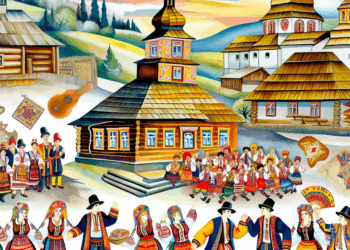Bukovyna is a unique region on the border of Ukraine and Romania, which is famous for its multinational composition, rich history and diverse cultural traditions. Ukrainians, Romanians, Jews, Poles and many other peoples live here, each bringing something different to the cultural context. In this article we will talk about folk costumes, crafts, festivals, music and folklore of Bukovina and their mutual influence.
Historical Context
Bukovina has been part of several state entities throughout its history, including the Principality of Galicia-Volhynia, Austria-Hungary, and the Romanian Kingdom. This diversity of influences has created a unique cultural collage where the traditions and customs of different peoples are woven together like a fabric.
Influence of Cultures
Each nation inhabiting Bukovina has left its mark on the cultural palette of the region.
-
- Ukrainian culture: Wears colourful features of folklore, folk music and dances such as gopak, which is performed in embroidered folk costumes.
-
- Romanian culture: Brought its own melodies and rhythms, as well as traditions of celebrating various rituals and holidays, such as Nicholas.
-
- Jewish culture: Influenced the region’s cuisine and musical traditions, such as Hasidic songs and melodies performed on violins.
-
- Polish culture: Introduced its architecture and folk dances, such as the mazurka, which is also popular among locals.
Folk Costumes
The folk costumes of Bukovina are a living symbol of cultural heritage. Each outfit reflects the atmosphere and spirit of its time.
Traditional Ukrainian Costume
Ukrainian people are characterised by embroidered shirts (saint), which are often decorated with luxurious embroidery depicting nature and shrines. Women’s outfits are complemented by skirts and aprons, as well as headdresses – wreaths or shawls.
Romanian Costume
Romanian folk costumes are distinguished by bright colours and exquisite patterns. Men wear white shirts and waistcoats, and women wear skirts with voluminous, brightly coloured blouses. These costumes are often used during holidays and special events.
Jewish Costume
Jewish traditions in Bukovina also have their roots in folk costumes. Although the Jewish community has greatly diminished, its legacy survives in the form of Torah scrolls and rituals that are still practised.
Crafts
The handicrafts of Bukovina are an important part of the region’s cultural heritage. Local craftsmen preserve and pass on their knowledge from generation to generation.
Woodworking
The woodworking craft in Bukovina is impressive in its complexity and craftsmanship. Sculptures, furniture and traditional ritual objects are made. Famous craftsmen are the Kovalenko and Luzhansky families, who continue the traditions of their ancestors.
Folk Ceramics
Ceramics is another important craft that many families are engaged in. Craftsmen make clay products such as crockery and decorative items decorated with brightly coloured patterns.
Weaving
Weaving in Bukovina has its roots in deep traditions. Women weave beautiful carpets and doormats that can be seen in the homes of locals. Each pattern and each colour has its own meaning, conveying the history of the family or the area.
Holidays and Rites
Festivals and rituals in Bukovina reflect the diverse cultural influences of the region.
Christmas and Easter
Christmas and Easter are major religious holidays celebrated by both Ukrainians and Romanians. Unique rituals such as “carols” and “generosity” are passed down from generation to generation.
Independence Day
Ukraine and Romania’s Independence Day is a significant date for both nations. Celebrations include parades, concerts and folk art exhibitions.
Jewish Holidays
The Jewish community also celebrates its traditional holidays such as Hanukkah and Passover. Special rituals and local festivals are held on these days to promote understanding and solidarity.
Music and Folklore
Music plays an important role in the life of Bukovinians and is a reflection of their essence and experiences.
Folk Instruments
Traditional folk instruments such as the trembita (a long wooden trumpet) and the dulcimer (a stringed instrument) create a unique sound atmosphere. Local musicians, such as Miron and Iryna Stepanets, continue the tradition by playing folk tunes.
Folklore Genres
The folklore of Bukovina is rich and varied. Inimitable melodies and rhythms are used both in festive events and in everyday life. Works such as “Oy, na gory dvoi dubki” or “Hail, earth” convey the spirit of love, mercy and patriotism.
Preserving Heritage
Preservation of Bukovina’s cultural heritage is an important task for local authorities and activists. Many events such as festivals, exhibitions and seminars are organised to popularise traditional culture.
Education and Grants
Local schools and cultural centres organise folk art lessons and workshops to provide the younger generation with skills in traditional crafts. Support from public and private organisations also helps to preserve and develop cultural values.
Festivals
Festivals, such as the Bukovyna Feast in Chernivtsi, bring together people of different nationalities and promote the exchange of cultural traditions. There are also food festivals where you can taste national dishes.
Conclusion
The culture of Bukovina is a vast mosaic of folk traditions, music and crafts, which were formed under the influence of different cultures. The multinational heritage of the region is a unique example of coexistence and mutual understanding. Preserving this heritage is not only important for the identity of local people, but also for future generations to be proud of their history and culture. Against the backdrop of history and modernity, Bukovina continues to be an example of diversity, where cultural, linguistic and religious differences enrich the overall picture.








